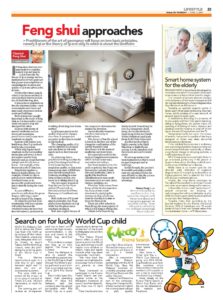(This is an article that I wrote in a column for the Sun Daily newspaper).
There are two approaches to Feng Shui, namely Li Qi and Xing Fa.
Li Qi (Theory of Qi) is a formula driven approach that places more emphasis on the calculating the location and quality of qi at any given point in time.
Xing Fa (Forms Method) popularly known as Luan Tou or Land form Feng Shui places more emphasis on the use of natural forms such as mountains and rivers and mad made structures such as roads and buildings.
Both systems are equally important in the study of feng shui, as it is impossible to just study one aspect of qi and disregard the other. In areas with plenty of natural land forms such as rivers and mountains, practitioners tend to pay more emphasis on Xing Fa. In areas with feature-less land forms, Li Qi methods tend to take precedent.
While Xing Fa pays much emphasis on the surrounding mountains and rivers, it does not neglect nearby forms features such as a road that runs straight and directly into a house, for example at the intersection of a T-junction. Also Xing Fa applies to feature inside a house. For example, “sha” emitted from a overhead beam, or an incorrectly positioned stove that is directly opposite the wash basin.
So, when you hear a practitioner talk about the green dragon, white tiger, water mouth or head of the dragon. Or when he says that your relationship with your spouse will suffer because the overhead beam cuts your bed into two, you know he is talking about Xing Fa or Forms Method.
Li Qi focus much on the quality of qi and its changes over time. A compass is a necessity as direction is crucial in this method. The changing quality of qi can be captured in a formula and calculated at will with inputs such as direction and time.
So, when you hear a practitioner telling you that the period has changed and the qi in the house has lost its auspicious quality. Or that some inauspicious stars will fall into your already inauspicious bedroom resulting in some form of illness in July, you know he is talking Li Qi
The two major schools of Feng Shui are the San Yuan school (Three Cycle or Periods) and San He (Three Harmony or Combinations) school.
Both makes use of Li Qi and Xing Fa principles. San Yuan place more emphasis on Li Qi while San He place more emphasis on Xing Fa. Both require the use of the compass to determine direction.
San He literally translates into three harmony or combinations. The theory of San He school is based on the four sets of the triangular combination of the earthly branches (and directions). It is the study of land forms and waterways. It is especially useful in the study of complex environments which include waterways, mountains and valleys.
San Yuan translates into the cycle or periods. San Yuan was first was used to evaluate burial sites and land forms. Later the San Yuan School applied the land form classifications to the man-made structures such as roads, dams, bridges, buildings etc.
From San Yuan comes Xuan Kong which also incorporate the study of man-made structure by studying the movement of qi, which was done by charting it in nine or 3×3 grids. There are a few schools in Xuan Kong the most popular of which Fei Xing or Flying Star.
Others in the Xuan Kong family include Xuan Kong Da Gua (64 Hexagram), Xuan Kong Liu Fa (6 methods), Xuan Kong Zi Bai Jue (Purple White Divination)
and Xuan Kong Ze Ri (Date Selection).
Another method that is highly popular is the Eight Mansions or Eight House system. It is the simplest of all the schools and can be learnt easily. Ba Zhai had been formulated so that it could be used for people and in buildings. In this formula the person’s favorable and unfavorable stars are calculated (from the year of birth) so that the person can use them to their advantage.
In the next article, I will write in external and internal Feng Shui with examples.

